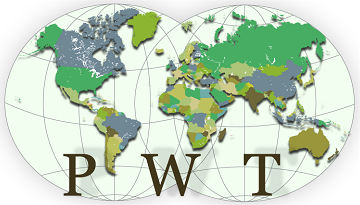Ranking of income levels worldwide now made possible by economists of University of Groningen

Why are some countries so much richer than others? The so-called
Penn World Table
(PWT) provides the data for answers and is now based at the University of Groningen. Dr. Robert Inklaar and professor Marcel Timmer of the Faculty of Economics and Business not only develop and maintain the PWT, but also implemented important innovations. Policy makers worldwide, who want to rank their country’s income level, can now turn to Groningen.
PWT, first constructed in the 1970s, is one of the most widely-used data sources in economics. Since the release of the newest version in Groningen in early July 2013, the data have been accessed over 10,000 times. The main users are economists and policy makers.
Understanding differences
“It has been one of the most enduring questions in economics: understanding why one country is rich, while the other is not,” says dr. Robert Inklaar. “Adam Smith, the godfather of economics, already titled his most-famous book ‘An Inquiry into the Nature and Causes of the Wealth of Nations’ in 1776. Since then many of the most famous economists, including Dani Rodrik, forthcoming honorary doctor in Groningen, have worked to understand these cross-country differences.”
New generation
Since the early 1970s the Penn World Table has been helping to solve the question why some countries are so rich. The database was developed and long-maintained by economists Irving Kravis, Robert Summers and Alan Heston of the University of Pennsylvania. Now, a new generation has taken over, with development in the hands of Robert Inklaar and Marcel Timmer at the Groningen Growth and Development Centre of the University of Groningen, jointly with Robert Feenstra of the University of California, Davis. The new data and all documentation is now available at www.ggdc.net/pwt.
Major innovations in Groningen
Inklaar: “This generational shift was not just passing the torch, but an opportunity for us to make PWT a much more useful source of information. The latest version has seen two major innovations.” First, the new PWT provides much more information about the sources of income differences. And second, regular updates of the data will no longer make research based on earlier versions unreliable.
Accounting for income differences
Countries can have high incomes if they get relatively favorable prices for their exports compared to the prices they pay for their imports; or if they have relatively high levels of human and physical capital; or if they use these inputs very productively. With the new PWT, users can trace how much each of these factors contributes to overall income differences.
New versions
The second innovation was to make the database more resilient to the availability of new data. A much-heard criticism of PWT heard in recent years has been that data would change so much with a new version that older research results could be overturned. By using more of the historical source material, the new version of PWT will provide a more stable record and thus a more reliable basis for economic research.
More information
Contact: dr. Robert Inklaar
| Last modified: | 12 April 2024 11.35 a.m. |
More news
-
25 April 2024
Lineke Sneller appointed as Professor of Practice of Digitalization & AI in Accounting and Auditing
The Faculty of Economics and Business (FEB) is pleased to announce that as of 1 May, professor Lineke Sneller will be appointed as Professor Practice of Digitalization & AI in Accounting and Auditing. The chair is situated within the department of...
-
25 April 2024
Jenny van Doorn and co-authors receive 2024 Weitz-Winer-O’Dell Award
Jenny van Doorn and co-authors Martin Mende, Maura L. Scott (both Florida State University), Dhruv Grewal (Babson College) and Ilana Shanks (Stony Brook University) have won the 2024 Weitz-Winer-O’Dell Award. They received the award for their paper...
-
19 April 2024
New thesis prize for master's students of Economics and Business
How can we encourage economics and business students to deal with important societal challenges in their master's thesis? The 14 Dutch faculties of economics and business, united in the Council of Deans in Economics and Business (DEB), have set up...
